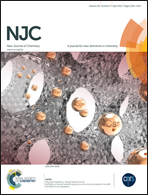Interaction of ruthenium(ii) antitumor complexes with d(ATATAT)2 and d(GCGCGC)2: a theoretical study
Abstract
Interaction of three ruthenium(II) complexes of the type [Ru(tmp)2(dpq)]2+ (I), [Ru(tmp)2(dppz)]2+ (II) and [Ru(tmp)2(11,12-dmdppz)]2+ (III) with two B-DNA hexamers of alternative AT and GC sequences, namely d(ATATAT)2 and d(GCGCGC)2 respectively, has been computationally investigated by using the molecular docking and two layer quantum mechanics/molecular mechanics hybrid method. Docking simulation reveals the intercalative minor groove binding mode of ruthenium complexes with DNA base pairs as well as their preferential binding to d(ATATAT)2 over d(GCGCGC)2. In addition, docking simulation reveals the greater binding affinity of complex III toward the DNA sequences compared to complexes I and II, which indicates that the methyl substituent effect of the intercalating ligand increases the binding affinity towards the DNA duplex. Binding energies of ruthenium complexes with DNA sequences obtained from two layer quantum mechanics/molecular mechanics calculations show higher stability of the III–DNA adduct as compared to the adducts of complexes I and II with DNA. The stability order for ruthenium(II) complexes with d(ATATAT)2 and d(GCGCGC)2 sequences is as follows: complex III > complex II > complex I. Thus molecular docking and quantum mechanics/molecular mechanics results suggest that intercalating ligands having substituent groups significantly increase the DNA binding affinity of the metal complexes.


 Please wait while we load your content...
Please wait while we load your content...